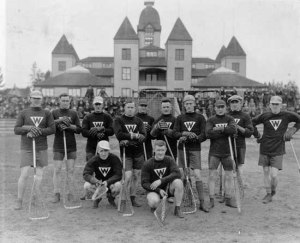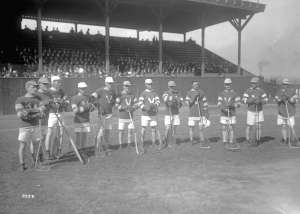
1918–1924 …Post-war Revival and the End of an Era
The Mainland Lacrosse Association was formed in 1918 with New Westminster and Vancouver as a pro league replacement to the inactive British Columbia Lacrosse Association.
However a year later at the BCLA Annual Meetings held on May 8 and 15, 1919, the Minto Cup Trustees and British Columbia Lacrosse Association refused to recognise the results of the Mainland Lacrosse Association series as being official. Vancouver had won the eight-game series but would not be awarded the Minto Cup. Vancouver claimed that they were in perfect order to organise a new league in lieu of the BCLA, which had suspended operations for the duration of World War One. New Westminster disagreed and claimed (somewhat well after the fact) that their club did not actually operate in 1918.
The professional British Columbia Lacrosse Association resumed play that season with the New Westminster Salmonbellies and the Vancouver Terminals – a new club founded by Pete Muldoon and Harry Pickering on May 19, 1919 and incorporated with $5,000 in capital as the Vancouver Terminal Lacrosse Company two months later around July 18, 1919. In the meantime, out of disgust with the recent situation with New Westminster, Con Jones walked away from the pro game and turned his attention to supporting the amateurs.
A year later, in 1920, the May 24 game saw the largest crowd turnout in New Westminster since the heady days of 1911. The Dominion Day match-up saw the novelty of four movie cameras in attendance along with numerous fans from Vancouver Island and from as far as Seattle and Tacoma. The large crowds continued throughout the season.
In late September and October of 1920, Con Jones met with his former star-player Billy Fitzgerald to lay out some plans to field a team to play against a Vancouver team involving Jones. Although never progressing beyond talk, conflicting and muddled news reports hinted that Fitzgerald would either organise and manage an unidentified eastern team to play a twelve-game schedule versus Vancouver or he would organise a Seattle lacrosse team to play in an ‘international league’ involving Vancouver and Montréal. Whether the failure of this international league bankrolled by Con Jones later lent weight to his Pacific Coast Lacrosse Association venture the following year involving Vancouver and Victoria (of which Billy Fitzgerald was a member), is unknown.

In April 1921 there were serious discussions between the Vancouver Terminals and the Montréal Shamrocks regarding a Minto Cup challenge in Vancouver. A three-game total-goals series was proposed by cup trustee Charlie Welsh to be played the following month – however the series then soon fell victim to a contract dispute within the Terminals organisation between the players and management, as well as uncertainty who exactly now held the Minto Cup due to the apparent split breaking out within the club into two factions.
May 1921 saw the formation of a second professional club in Vancouver – the Vancouver Lacrosse Club, fronted by Con Jones – after a large majority of the players with the Vancouver Terminals then bolted to sign with Jones due to money issues. After the New Westminster Salmonbellies declared their refusal to play Jones’s new team and stated they would only compete against the Terminals for the Minto Cup, Jones responded by forming a Victoria club and starting up a second, professional league for his team to play in.
This new league was called the Pacific Coast Lacrosse Association (different from the amateur PCALA in existence at the same time) and consisted of the new Vancouver Lacrosse Club and Victoria Capitals. With two professional leagues in operation simultaneously, as many as 16 players were recruited from Ontario – the majority signing with the Vancouver Terminals in the BCLA as replacements for those players lost to the Vancouver Lacrosse Club team in the PCLA. Victoria Capitals also benefited from the influx of Easterners to buttress their roster. Amongst all this roster movement, only New Westminster seemed unaffected.

However, soon after the PCLA played its first game, it was obvious to all that Victoria was seriously outclassed and talks began to merge into a three-team league with two Vancouver clubs and the Salmonbellies. No merger agreement was able to be worked out – and after five games into the season, the PCLA disbanded on June 13, 1921. Four days later, the Vancouver Lacrosse Club applied to join the BCLA but their request was denied. As the rest of the BCLA season played out, some Vancouver players in the PCLA eventually made their way back to their original BCLA club from which they had departed.
The 1922 BCLA campaign proved to be one of the best on the field for competitiveness as New Westminster took the championship by just two wins all the while conceding more goals than scoring versus their Vancouver opponents. Unfortunately, the following year saw the league become a fatality in September 1923 with two games remaining to be played; like many previous seasons lost during mid-season, it was due to a grievance over scheduling.
As with every other season before it, 1924 started with a lot of promise. But in the end, it proved to be the final curtain call when professional lacrosse in British Columbia died an inglorious death on June 2, 1924. Sadly, just as Con Jones had a hand in building up the professional game in Vancouver, he would have a hand in its demise in that city, and ultimately in Canada – as its last bastion was on the Pacific Coast. Four games into the season, Jones suddenly and without warning threw in the towel.
Like a ‘bolt from the blue’, as one newspaper commented, Jones was forced to quit the game on his doctor’s orders. When local baseball legend Bob Brown then offered to step in and take Jones’s place leading the Vancouver club, the rescue attempt was quickly quashed when Jones flatly refused to allow his park to be used free of charge to help keep the national game alive.
As the Vancouver Province stated: “And that’s that. Con Jones is through.” – and so died the last remnants of the pro lacrosse game in Canada.
(PHOTO SOURCES: NWMA IHP0371; CVA 99-905; CVA 99-1018.8 )